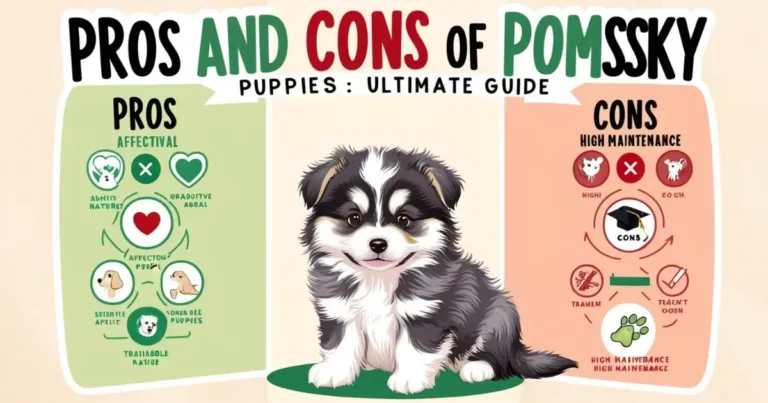How to Train a Pomsky Puppy with Ease: Master the Art

Training a Pomsky puppy, a delightful hybrid of a Pomeranian and a Husky, can be both rewarding and challenging. These dogs are known for their intelligence, energy, and a touch of independence, which requires a thoughtful and structured training approach. Proper training ensures they grow into well-mannered companions and helps strengthen your bond with them.
This guide focuses on proven tips and techniques to train a Pomsky puppy, combining patience, positive reinforcement, and a deeper understanding of their personality.
Table of Contents
Understanding Your Pomsky Puppy’s Personality
Traits of a Pomsky Puppy
Pomskies have distinct personality traits inherited from their parent breeds:
- High intelligence: Pomskies are quick learners thanks to their Pomeranian lineage.
- Independence: Their Husky side brings a streak of stubbornness, making consistency vital during training.

“Training my Pomsky was an exercise in patience and creativity. Their quick wit often surprised me, but their independence meant I had to stay persistent,” I’ve found.
Why Personality Matters in Training
To successfully train a Pomsky puppy, it’s crucial to understand their energy and temperament. Their intelligence makes them eager learners, while their high energy levels mean they need plenty of physical and mental stimulation.
Adapt your training to these traits by:
- Keeping sessions engaging and fun.
- Incorporating rewards to motivate them.
Understanding their personality helps you approach training with empathy, making it a more enjoyable experience for both you and your Pomsky.
Essential Early Training for Your Pomsky Puppy
Patience and Consistency
Training requires patience. Pomskies may test your limits, but remaining calm and consistent is key.
“I’ve learned that sticking to a routine and using the same commands repeatedly helps Pomskies understand what’s expected,” I often say. They thrive when they know the rules and boundaries.
To stay patient:
- Take breaks when either you or the puppy becomes frustrated.
- Celebrate small wins during training sessions.
Early Socialization
Socialization is one of the most important steps in early training. Exposing your puppy to new people, environments, and other animals helps them become well-adjusted adults.
Here’s how I’ve successfully socialized my Pomsky:
- Supervised play with other dogs: Mature dogs teach them boundaries naturally.
- Encouraging positive interactions: Introduce your puppy to various situations to reduce fear or anxiety.
“Watching my Pomsky learn from older dogs was a game-changer. They quickly learned acceptable behavior through playful interaction,” I’ve noticed.
Short, Enjoyable Sessions
Pomskies have short attention spans, so keep training sessions brief and enjoyable.
Tips for effective short sessions:
- Use interactive games to hold their focus.
- Reward them immediately after successful attempts.
“Training a Pomsky isn’t just about discipline—it’s about having fun together,” I always remind new owners.
Pomsky Training Essentials
| Training Aspect | Key Tips |
| Patience and Consistency | Use the same commands and stay calm. Celebrate small wins. |
| Early Socialization | Introduce to new people, environments, and dogs. Supervise play sessions. |
| Bite Prevention | Redirect biting to toys. Correct gently but firmly. |
| Whine Prevention | Gradually extend alone time. Build trust through crate training. |
| Obedience Training | Reward good behavior and redirect unwanted actions. |
| Leash Training | Stop pulling by restarting walks. Use treats to encourage good behavior. |
| Mental Stimulation | Provide puzzle toys and engaging activities to keep them focused. |
Key Training Techniques for Common Pomsky Challenges
Bite Prevention Training
Like all puppies, Pomskies explore the world with their mouths. Teaching them to control their bite is crucial.
Steps for Pomsky bite prevention:
- Allow supervised play with mature dogs to learn bite inhibition.
- Redirect their biting to toys or chewable items.
- Discourage hard bites by stopping play temporarily.

“When my Pomsky bit too hard, I gently said ‘no’ and offered a toy instead. It taught them what was acceptable without creating fear,” I’ve experienced.
Whine Prevention Training
Pomskies aren’t naturally whiny but may occasionally cry for attention. To prevent this behavior:
- Gradually increase the time you leave them alone.
- Use crate training to build their sense of security.
“Each time I left my Pomsky alone, I extended the duration bit by bit. They soon learned that I’d always return, and the whining stopped,” I’ve found.
General Obedience Training
General obedience training establishes a strong foundation for a respectful relationship.
Focus on:
- Positive reinforcement: Reward good behavior with treats or praise.
- Firm but gentle correction: Redirect unwanted behavior calmly.
Examples of redirection:
- If your Pomsky chews furniture, replace it with a chew toy.
- Reward them when they follow a command successfully.
“When you balance discipline with encouragement, your Pomsky feels respected and motivated to behave,” I’ve observed.
Advanced Training Tips for Pomsky Puppies
Leash Obedience Training
Leash training a Pomsky can take time, as their enthusiasm often leads to pulling.
Tips for leash obedience for Pomskies:
- Set up a training routine with short walks.
- Stop and restart if they pull the leash.
- Use treats as motivation to walk calmly.
“I used a treat placed a few meters ahead to encourage my Pomsky to walk beside me. Over time, they learned to resist pulling,” I’ve experienced.
Mental Stimulation and Physical Exercise
Pomskies thrive on both physical and mental challenges.
Activities to stimulate your Pomsky:
- Puzzle toys for mental engagement.
- Agility courses to combine exercise with focus.
“Keeping my Pomsky mentally stimulated was just as important as physical play. It kept them calm and happy,” I’ve observed.
Final Thoughts on Training a Pomsky Puppy
Training a Pomsky puppy requires a mix of patience, understanding, and creativity. Start early, be consistent, and focus on positive reinforcement.
“Every training session is an opportunity to deepen your bond with your Pomsky. Celebrate progress and enjoy the journey,” I like to say.
With time and effort, your Pomsky will grow into a well-mannered, obedient companion you can be proud off.
FAQs
When should I start early training for my Pomsky puppy?
Begin early training for Pomsky puppies as soon as you bring them home. The first 8–12 weeks are ideal for socialization, establishing routines, and teaching basic commands like "sit" and "stay."
What’s the best way to prevent biting behavior in a Pomsky puppy?
For effective Pomsky bite prevention, redirect their biting to toys during play. Supervised interaction with mature dogs also helps teach bite inhibition naturally. Avoid harsh punishment and reinforce positive behavior with rewards.
How can I train my Pomsky to stop whining when left alone?
To achieve whine prevention training, gradually increase the time you leave your puppy alone. Start with a few minutes in a crate and extend the duration over time. Build their confidence and assure them of your return.
What are advanced training techniques for Pomsky leash obedience?
For leash obedience for Pomskies, practice walking in quiet areas. If your Pomsky pulls, stop and reset. Reward them for staying close with treats or praise. Over time, this consistency builds excellent leash manners.






